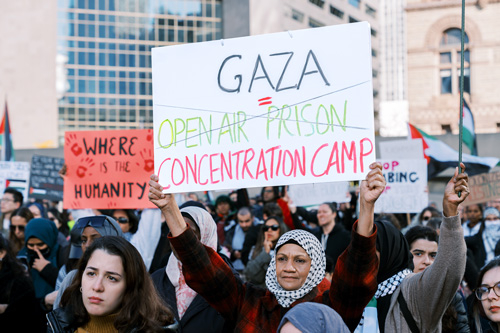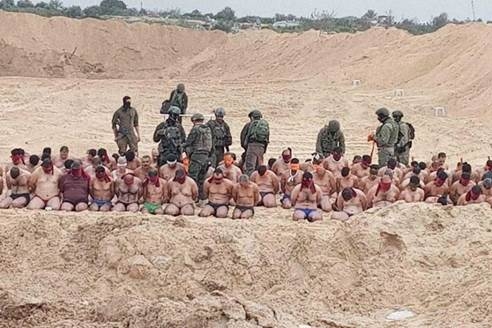 Toronto, Canada – Oct 28 2023: Woman holds sign about Gaza, likening it to an open prison and concentration camp. – Image Credit: Shutterstock.com/nadtochiy |
According to Ilana Feldman, the term "open-air prison" was first used in 1997 in the Philadelphia Inquirer and quickly found currency among Irish and Canadian journalists in the early 2000s. It became a staple of anti-Israel rhetoric in the U.S. in 2009 after Rep. Ron Paul (R-TX) claimed (in a campaign video and on Iranian television) that "The Palestinians are virtually in a concentration camp."
In 2010, British PM David Cameron said that "People in Gaza are living under constant attacks and pressure in an open-air prison," adding that "Gaza cannot and must not be allowed to remain a prison camp."
From politics to pop-culture, it grew like an infectious meme in 2015, when the graffiti artist (pardon the oxymoron), Banksy, went to Gaza to spray-paint on some walls. He photographed them for his website, and added witty captions, like: "Gaza is often described as 'the world's largest open air prison' because no-one is allowed to enter or leave."
Of course, people leave and enter Gaza all the time. Prior to October 7, thousands of people left Gaza every day, crossing into Israel to work at jobs that paid them five times more than they could earn in Gaza. That arrangement is over, thanks to Hamas.
There is also a border with Egypt and the Mediterranean Sea. And, lest anyone forget, there is a maze of underground tunnels one recently-freed Israeli hostage calls "Lower Gaza" which presents numerous illegal exit opportunities.
As Ari Zivotofsky observes in the Jerusalem Post, a September 19, 2023, episode of the Palestinian television show Emigration claimed that, "in the past 15 years a quarter of a million young Palestinians left for abroad." In 2022, over 15,000 of them who lived abroad (having apparently escaped the "prison") willingly returned to it to celebrate the feast of Eid al-Adha.
This is not how prisons work.
The Middle East Media Research Institute (MEMRI) has been running a series on "Gaza Before October 7" refuting the "concentration camp" and "open-air prison" claims with pictures and videos. The first two episodes follow Palestinian "influencer" Yousef Alhelou as he travels around Gaza, showing off the top spots for tourists, including a gold market. Subsequent episodes include an Al-Jazeera feature of the economic boom in Gaza, Turkish television reports on the markets of Gaza, and various Arab media outlets covering the many sporting events in Gaza.
Hamas propagandists argue that Gazans are denied goods and services they are entitled to because of Israel's "land, water, and sea blockade," but Israel only blocks weapons from entering Gaza. Even after October 7, Israel has continued to supply electricity, food, and medicine.
What the "pro-Palestine" luminaries will never admit is that Israel has been forced into controlling Gaza's ports by the long history of weapons shipped there. In 2001, two vessels, the Calypso and the Santorini, were seized with weapons destined for Palestinian terrorists, and in 2002, a Palestinian ship called the Karine A was seized with 50 tons of Iranian weapons destined for Gaza. Since then, Israel has acted to prevent further shipments of weapons from reaching Gaza by sea. In 2007, after Hamas took over Gaza completely, Israel imposed an inspections regime and began more aggressively searching ships for smuggled weapons. Food and medicine are not prevented from entering Gaza.
Poor access to healthcare is another complaint about life in the Gaza "open-air prison." In April 2023, the Jerusalem-based anti-Israel activist group B'Tselem faulted Israel for preventing Palestinians from leaving Gaza in order to be treated in Israeli hospitals. But Israel treats plenty of Palestinians. Hamas leader Ismail Haniyeh sends his entire family to Israel for medical care. In 2013 his 1-year-old granddaughter was treated in an Israeli hospital; in 2014 his daughter was treated at Tel Aviv's Ichilov Hospital and his mother-in-law was treated at Jerusalem's Augusta Victoria Hospital; in 2021 his niece was treated at Ichilov Hospital. Just this month, it was reported that Haniyeh's grandniece was being treated at the Soroka Medical Center in Beersheva. But why should any Gazans be treated in Israeli hospitals? There are 36 hospitals in Gaza, many of which are run by foreign nations (Indonesia, Turkey, Jordan, Europe countries) serving a population of around 2 million.
Of course, hospitals in Gaza are dual-purpose buildings, offering both healthcare and camouflage for the entrances to Hamas's elaborate subterranean infrastructure. An IDF spokesman said that "Hamas systematically built the Indonesian Hospital to disguise its underground terror infrastructure." The Al-Shifa hospital, where IDF soldiers found a stash of rifles, ammunition, and ballistic vests, also sits atop a major tunnel junction. IDF soldiers recently found unopened boxes of medicine for Israeli hostages at the Nasser Hospital in Khan Younis.
If Gaza is a prison, Hamas is the jailer.
The accusation that Israel withholds food from the "open-air prisoners" of Gaza is a common one. In 2010, Sarah Leppert of the U.N. Food and Agricultural Organization said that "sixty-one percent of the Gaza population is food insecure." A U.N. World Food Program's country brief on "Palestine" for the year 2022 announced that Gazans account for 90% of the 1.84 million Palestinians "suffering from food insecurity." But media reports about the vibrant lives of people "under occupation" have long included photographs of Gaza showing bountiful markets with merchants whose stands are stocked with fruit and vegetables. As Robert Spencer pointed out recently, "The 'open air prison' of Gaza was actually quite opulent" before October 7. Spencer links to a video posted to X by a Gazan who complains that Gaza was beautiful before October 7. In the 42-second video, Gaza's opulent markets, vacationing tourists, and shops of all sorts look like what one would expect in a tropical resort town.
In fact, there are shops of all kinds in Gaza, like any other city in the world, except perhaps for one – it's hard to imagine a store named for Adolph Hitler anywhere other than "Palestine," but in Gaza there's one called Hitler2, which first achieved infamy in 2015. The store, with its knife-grasping mannequins, was reported damaged in recent fighting. Where will the poor citizens of Gaza buy their Holocaust tchotchkes now?
After October 7, the rhetoric heated up. When Israel briefly announced that it would cease supplying water and electricity to the people who had just killed over 1200 Israelis and taken another 250 as hostages, the world flew into another outrage.
Human Rights Watch accused Israel of using starvation as a weapon. Israel denied the charges, pointing out that Hamas hijacks food and fuel for itself. Even the New York Times agrees that Hamas has long stockpiled the food and medical supplies meant for the people of Gaza. It quoted a Lebanese source to assert on October 27 that, "Hamas has hundreds of thousands of gallons of fuel for vehicles and rockets; caches of ammunition, explosives and materials to make more; and stockpiles of food, water and medicine ... enough stocked away to keep fighting for three to four months without resupply."
 Source: X (formerly Twitter) |
With so much attention focused on Israel's alleged immorality in showing the photographs, many overlooked what they revealed: dozens of flabby fedayeen untouched by food insecurity.
Anyone who argues that they are not Hamas members but merely innocent Palestinians caught up in the fog of war will have to admit that at least these inmates from the "open-air prison" are very well fed.
Quick links to all 6 parts in the Series:
- Part 1: Resistance is Justified When People Are Occupied
- Part 2: Israel is a Settler-Colonial State
- Part 3: Israel is an Apartheid State
- Part 4: Genocide and Ethnic Cleansing
- Part 5: Gaza is an Open-Air Prison
- Part 6: Palestinian Refugees' Right of Return
 IPT Senior Fellow A.J. Caschetta is a principal lecturer at the Rochester Institute of Technology and a fellow at Campus Watch, a project of the Middle East Forum where he is also a Milstein fellow.
IPT Senior Fellow A.J. Caschetta is a principal lecturer at the Rochester Institute of Technology and a fellow at Campus Watch, a project of the Middle East Forum where he is also a Milstein fellow.
